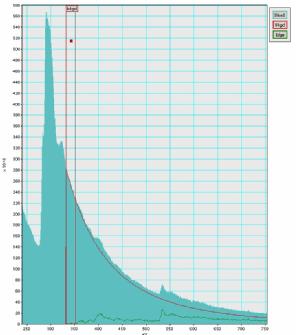Spectroscopy
Elemental analysis can be carried out on samples to determine the elements present within a sample.
Energy Dispersive X-ray Spectroscopy (EDX)
Energy dispersive X-ray spectroscopy, referred to as EDX here but also known as EDS. EDX uses electrons to excite a sample, which then provide a characteristic peak for each element from the X-rays emitted. Many of the electron microscopes within the EM RTP have the ability to do EDX analysis of a sample, including the Zeiss SUPRA 55-VP SEM, the Zeiss Gemini SEM, the Jeol 2000FX TEM, the Jeol 2100 LaB6 TEM and the Jeol ARM 200F TEM.
Electron Energy Loss Spectroscopy (EELS)
 |
An example EELS spectra. |
The Jeol ARM 200F is fitted with a Gatan Quantum SE EELS system, in addition to a EDX system. EELS can be seen as the complement of X-ray analysis. When an electron excites an X-ray of a specific energy, conservation of energy dictates that the electron emerging from the sample will have lost exactly the same energy as that given to the X-ray. If we look at a spectrum of the electron energy, we can see 'edges' at these specific energies, which can be used to determine and quantify elemental composition. In EELS the electrons have (almost) the full energy of 200 keV and so it is possible to detect and quantify elements such as He, Li and Be which are invisible to EDX.
EELS system, in addition to a EDX system. EELS can be seen as the complement of X-ray analysis. When an electron excites an X-ray of a specific energy, conservation of energy dictates that the electron emerging from the sample will have lost exactly the same energy as that given to the X-ray. If we look at a spectrum of the electron energy, we can see 'edges' at these specific energies, which can be used to determine and quantify elemental composition. In EELS the electrons have (almost) the full energy of 200 keV and so it is possible to detect and quantify elements such as He, Li and Be which are invisible to EDX.
Featured on this page:
Zeiss SUPRA 55-VP |
Zeiss Gemini |
Jeol 2000 FX |
Jeol 2100 LaB6 |
Jeol ARM 200F |
